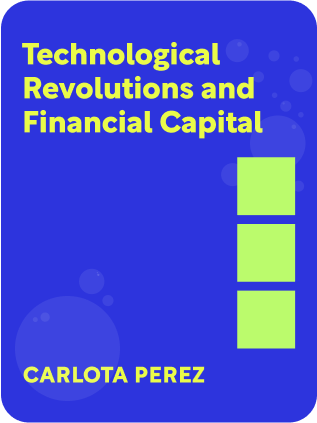

This article is an excerpt from the Shortform book guide to "Technological Revolutions and Financial Capital" by Carlota Perez. Shortform has the world's best summaries and analyses of books you should be reading.
Like this article? Sign up for a free trial here .
What are technological revolutions and how do they occur? What technological revolutions have there been in human history?
Technological revolutions happen when new technologies cause economic development. They cause a permanent change in society and how it operates.
Keep reading to find out more about how technological revolutions happen.
What Are Technological Revolutions?
A technological revolution is a cluster of new technologies, products, and industries causing an upheaval in the economy and propelling a long-term surge in development.
The five technological revolutions of the past 2 centuries, with their approximate start date:
- Industrial revolution in 1771
- Steam and railways in 1829
- Steel, electricity, and heavy engineering in 1875
- Automobile and mass production in 1908
- Information and telecommunications in 1971
Progress does not happen linearly and constantly. Instead, technological revolutions happen in predictable cycles, spanning ~50 years:
- Installation
- A new promising technology sees explosive growth as venture capitalists, seeking high profits, invest in new activities and firms.
- Investments reach irrational exuberance level. Many early expectations will be disappointed, leading to collapse of bubbles created by financial speculation.
- However, this boom installs the infrastructure that paves the way for…
- Deployment
- A robust growth occurs, built on the infrastructure of installation. The technology becomes widely adopted across the economy and leads to fundamental growth in a “new economy.”
- In maturity, the technology sees diminishing returns. The main companies have merged and become oligopolies, reducing the ferocity of competition and a common interest in comfortable profit margins. Arthritis sets in for the new incumbents .
- Attention shifts to the next generation of radical innovations, thus continuing the cycle
Much is said about the evils of finance in propping up bubbles and profiting from technology. Instead, financial capital is crucial in the installation and deployment of new technology.
- When the previous paradigm matures, it seeks radical innovations for growth.
- When the technological revolution appears, financial capital draws attention to it through (inflated) profits.
- When the bubble bursts, it facilitates production capital in diffusing the new revolution.
Society shapes the development of the revolution, through initial inertia from the previous revolution, then mass acceptance and diffusion of the new revolution.
- To make way for the new revolution, institutional creative destruction will take place, dismantling the old framework and installing the new. This means changes in regulation, politics, and ideology.
Understanding this framework can help you counter erroneous common wisdom at different phases.
- During Frenzy, the common wisdom is that growth cannot stop and good times are here, leading to irrational exuberance. Yet a correction will likely occur.
- During Deployment, the recession may cause pessimism regarding the full potential of the revolution. In reality, markets may be much larger, and costs lower, than anyone predicted. Thus you may benefit by envisioning the full potential of each revolution.
- One cannot extrapolate any current period as the “new permanent” or the final crisis of capitalism.
Technological Revolutions and Techno-Economic Paradigms
The technological revolution is a cluster of new technologies, products, and industries that causes an upheaval in the economy and propels a long-term surge in development.
These technological breakthroughs spread far beyond the industries and sectors from which they originated – they cause broad jumps in productivity for a broad span of economic activities. Economically, the technology brings a shift in price structure (often by making things significantly cheaper) that guides economic agents toward use of the new technologies. Hence Carlota Perez calls these “techno-economic paradigms.”
Even further, the technological revolution penetrates social practice, legislation, governance, and ideology. It becomes the general and shared “common sense” of the period, a new way of doing things that approaches something like the ‘ideals’ of the period. It creates new mental maps of all social actors and institutions.
There have been 5 technological revolutions in the past 2 centuries. We’ll give an overview, then dive further into how each one fits the above model:
| Revolution | Core country | Big-bang event | Year |
| Industrial Revolution | Britain | Arkwright’s mill in Cromford | 1771 |
| Steam and Railways | Britain | ‘Rocket’ steam engine for Liverpool-Manchester railway | 1829 |
| Steel, Electricity, and Heavy Engineering | USA and Germany | Carnegie Bessemer steel plant in Pittsburgh | 1875 |
| Oil, Automobile, and Mass Production | USA (and Germany) | First Model-T out of Ford plant in Detroit | 1908 |
| Information and Telecommunications | USA | Intel microprocessor announced in Santa Clara, CA | 1971 |
Properties
The innovations that create the technological revolution gestate for some time before they make their huge impact. But a revolution needs a highly visible attractor to appear, symbolizing the new potential and sparking the imagination of pioneers. Often the attractor is not only a technological breakthrough, it is also cheap or opens new cost-competitive possibilities for industry. Perez calls this a big-bang. Often, these events can only be identified in hindsight, since at the time they’re obvious only to a narrow community.
Geographically, the revolution often gestates in a particular region, and propagates from core to periphery. This means the time that the new technology is deployed is not the same for all countries and can be delayed by decades. Globally, the full revolution may take a full century.
The new technologies prompting revolutions are not isolated; often many products had existed for some time playing minor roles, until the new technology offers it unprecedented value and scale. Oil and automobiles had both been developed since the 1880s, but the combination of them with mass production in the 1900s led to a revolution in affordable automobiles for the general public. Likewise, transistors and semiconductors were available in the 1950s, but the microprocessor made visible the potential of cheap microelectronics, the “computer on a chip.”
Each revolution consists of several technology systems that develop at different rhythms and in a sequence depending on feedback loops. The information revolution began with chips and hardware, leading to software and telecom, leading to the Internet, leading to mobile. Each of these can appear as separate revolutions rather than interdependent systems under a wider umbrella – each smaller system benefits from the previous mini-revolution, while also reinforcing the overall paradigm to which it belongs.
Revolutions often involve significant changes in direction, uninstalling what was previously installed, unlearning much of the old to learn the new, closing dead end paths as others are jumping onto new bandwagons. Thus, often the radical innovations come from outsiders who have not been imbued with the previous paradigm.
The nature of the paradigm can favor certain comparative advantages unique to a society or nation. The fourth revolution of mass production favored large homogeneous populations, thus favoring the USA and the Soviet Union over more heterogeneous populations like Europe.
Society’s Role
Society shapes technological revolutions by cycling between inertia and desire for growth.
At first, society feels inertia. Each revolution is initially received as a threat to the established way of doing things in firms, institutions, and society – which have all optimized for the previous revolution. The new economy implies job losses, geographic displacement, and unaddressed regulatory challenges. The unfolding of the new revolution’s potential thus begins chaotically, causing a mismatch between the economy and socio-institutional systems.
- For instance, the Suez Canal eliminated ships from the route to India and cut travel time from 3 to 1 month, obviating the network of cargo depots in England and threatening big trading companies.
- Mass-produced automobiles displaced steam-powered trains and horse-drawn carriages, and all the industries associated with either (economies of towns at train stops, veterinarians for horses).
As the technological revolution spreads through society, frictions mount. Political pressure begins calling for action to propel the required institutional changes to accommodate the new revolution. Often the most persuasive event to induce changes in regulation is the financial collapse of the bubble of “irrational exuberance.” This spurs adaptations in government, education, and social behaviors, until the revolution becomes the “new common sense.” Only when the revolution has this proper context in society can the “golden age” of growth proceed.
As the revolution becomes the new prevailing paradigm, it favors compatible innovations and it excludes incompatible innovations. An innovation that fits in the natural trajectory of the prevailing paradigm is readily accepted by society, allowing progress. In contrast, incompatible innovations may be rejected by investors or consumers, and are instead adapted in a minor way to the current paradigm, even though they may very well be the focal point of the next technological revolution.
As the revolution matures, technological innovation shows decreasing returns and markets become saturated. Growth and profits are threatened. Social unrest reoccurs when the growth that was promised earlier in the revolution does not materialize. This is the point of greatest reception to radical innovations, and firms experiment with new technologies to revitalize themselves. Promising innovations attract idle capital, and the big-bang event kicks off a flywheel effect of capital and labor that leads to the next revolution cycle.
Thus, Carlota Perez maintains that society shapes innovation to occur in these predictable revolutionary cycles, providing both a propelling and dampening force at different phases.
When there is inertia in one sphere of change, unrest in another exercises enough pressure to induce changes. When there is inertia in technology, unrest in the financial sphere (from declining profits) and social sphere (from wealth inequality) prompts looking for radical technology innovations. Likewise, unrest in technology forces past the inertia in the social sphere.

———End of Preview———
Like what you just read? Read the rest of the world's best book summary and analysis of Carlota Perez's "Technological Revolutions and Financial Capital" at Shortform .
Here's what you'll find in our full Technological Revolutions and Financial Capital summary :
- What happened during the 2000 tech bubble and the 2002 crash
- The 5 technological revolutions that reshaped society since 1771
- How you might be able to predict and prepare for the next technological revolution






